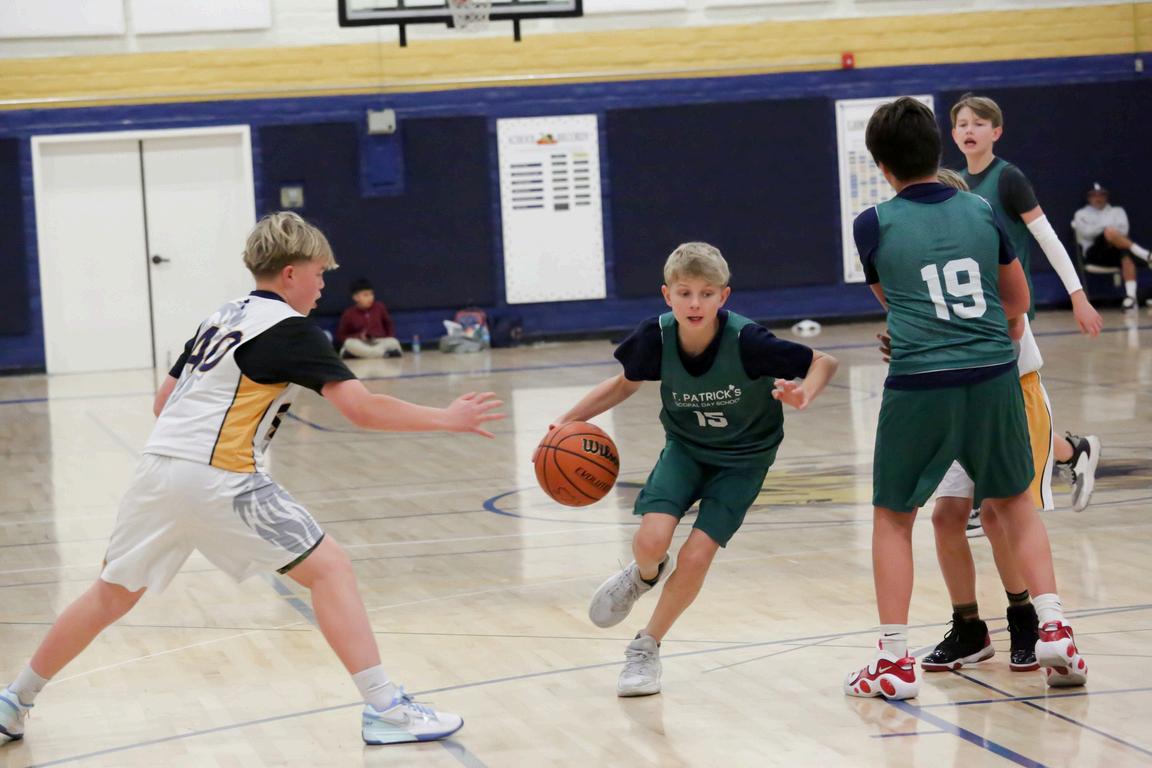STATE
OF THE SCHOOL 2024-25









OF THE SCHOOL 2024-25








Each day, I feel incredibly grateful to serve this wonderful community. Reflecting on the past year and a half, I am inspired by all we have accomplished honoring our core values, upholding academic excellence, and deepening our commitment to our Episcopal identity. At the same time, we continue to improve, reflect, and refine our efforts to position St. Patrick’s as the premier elementary and middle school in the Conejo Valley.
As we present our second annual State of the School, we aim to offer valuable insight into both our daily operations and the strategic vision guiding St. Patrick’s. I extend my sincere appreciation to Rev. Sarah Kitch, Renee Pantoja, Michael Malecki, and CJ O’Keeffe for their contributions to the State of the School presentation. This publication serves as a summary of that event.
We hope this report leaves you feeling informed, engaged, and united in our shared love for St. Patrick’s. Together, we are building an exceptional educational experience within a community rooted in kindness and purpose.
- Jayme L Johnson, Ed D Head of School

At St. Patrick's Episcopal Day School, our mission is to inspire and equip children to courageously transform the world.
In parallel with our Mission, our program is supported by our Heritage Statement.
Since 1963, St. Patrick’s Episcopal Day School has established a legacy of exceptional teachers partnering with diverse parents to educate and develop the whole child based on our dedication to four foundational principles:
Academic Excellence
Stimulating critical thinking in a collaborative environment
Creativity
Growing students’ confidence through individual expression in a loving community
Service Leadership
Fostering a commitment to social responsibility and global citizenship
Spiritual Foundation
Guiding each child to develop a moral character based on the Episcopal traditions of integrity, compassion, and inclusion
As part of our accreditation work, faculty began extensive curricular alignment conversations last year. After carefully examining each subject area, science emerged as a key area for improvement. This year, we adopted Amplify Science for grades K-5 and OpenSciEd for middle school, along with That Health Class curriculum for health and wellness.
Science at St Patrick’s takes a phenomenon-based approach, blending hands-on investigations, literacy-rich activities, and interactive digital tools to empower students to think, read, write, and argue like real scientists. Each unit begins with a phenomenon an attention-grabbing image or video designed to spark curiosity and encourage inquiry.
For example:

Second graders put on their engineering hats to develop a better glue, learning about substances and properties of select ingredients. Students then set a design goal and created a recipe of their perfect glue. They culminated the unit by writing persuasive letters to Dr. Johnson advocating for the best glue recipe for our school to use. More recently, they have been acting as geologists, learning about landforms and erosion within a national park.

Third graders are exploring inheritance and traits through the story of Wolf 44, a wolf with unique traits compared to its pack. Acting as wildlife biologists, students study genetic variation, inherited vs environmental traits, and even graph their own dominant and recessive traits. This week, they brought DNA to life by building color-coded double helix models out of candy.
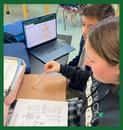
Seventh graders are currently studying body systems, recently focusing on the skeletal system They carefully sketched and labeled their skeletons before bringing them to life using dried foods like pasta, pretzels, nuts, and cookies! While food isn’t always part of hands-on projects, it can be a great motivator for creativity no two skeletal models looked exactly alike!
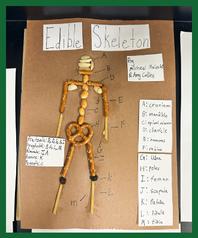

Our new That Health Class curriculum consists of 40 lessons across grades 4-8, covering physical, emotional, social, and relational health. Each grade level has eight foundational lessons, including topics like consent and body image, tailored to students' developmental stages.
We selected this curriculum because it is:
Adaptable & customizable – It allows us to tailor lessons to fit the unique needs of our school.
Comprehensive – Lessons align with state standards but can be adjusted based on our priorities
Since this is our first year using That Health Class, our teachers are integrating units from multiple grade levels while developing an implementation plan to fully phase That Health Class into our curriculum over the next few years.
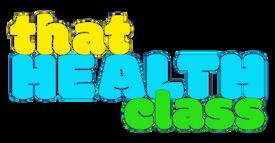
Social Studies: We introduced Little Thinkers Social Studies (K-2) and Savvas MyWorld Interactive Social Studies (grades 3+), providing updated, standards-based content while supporting extension experiences like the 5th-grade play, artist reports, and our new Renaissance Fair.
Handwriting Without Tears: A phased rollout is in progress, with KR, K, 2, and 4 implementing the program this year and grades 1 3, and 5 scheduled for next year.
Our Middle School program provides students with a unique and enriching experience while remaining connected to our KR-8 community. Leadership opportunities such as buddies, family groups, and chapel talks allow students to develop confidence and hone public speaking skills. This year ’ s Middle School Preview Night highlighted the depth of our program, and we look forward to expanding it next fall to include parents of all grade levels and prospective families. Our student panelists never fail to impress with their poise, passion, and even humor—this year, they spent 15 minutes enthusiastically discussing math! Academically, we transitioned to a departmentalized structure this year and will refine it further next year with four core teachers. In addition to our exceptional academic program, students benefit from specialist classes, electives, leadership and service learning, field trips, and outdoor education experiences, including trips to Santa Cruz Island, whitewater rafting in Sacramento, and historic sites like Washington, D.C., Jamestown, and Williamsburg.
St Patrick's proudly participates in the Tri Valley Christian Athletic League, offering students in grades 4-8 the opportunity to develop athletic skills, teamwork, and sportsmanship through competitive play. The league features three seasons: Fall Co-Ed Flag Football, Winter Boys and Girls Basketball, and Spring Boys and Girls Soccer. Students at St. Patrick's compete against other schools in a fun, supportive environment.





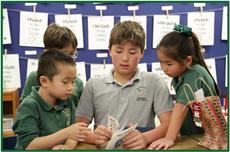
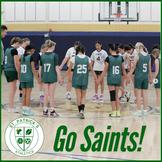
AtSt Patrick’s,weembraceaWholeChildapproachtostudentassessment, recognizing that each student is unique, with their own strengths and challenges. Our low student-to-teacher ratio enables teachers, specialists, and teaching assistants to form meaningful relationships with each child, allowing us to better understand when to provide additional support and when to allow for independent growth. This personalized approach enhances our assessment process, which includes informal observations of skillsandsocial-emotionaldevelopment,alongwithformativeassessmentsto gauge how students are mastering concepts and what further instruction might be needed Formal, summative assessments also play a role in measuringacademicgrowthandcontentmastery.
In addition to classroom assessments, we utilize standardized, nationally normed testing from the Educational Review Board (ERB) to provide further insights in grades 3 and above The ERB Whole Child Solution offers valuable data-driven insights about a student's academic progress, socialemotionalskills,andlevelsofengagement.Thiscomprehensivetoolprovides data to inform teaching practices, help students navigate academic and socialdemands,andsupporttheiroveralldevelopment.
Milestones: These are used in the Fall and Winter as regular check-in pointstoassessprogressandguideinstruction.
Check-In Survey: This short, 5-minute survey is conducted every 6-8 weeks, helping us track students' emotional well-being, academic engagement, and feelings of fairness and belonging. This allows us to monitorprogressovertimeandsupportstudentgrowth.
CTP (Comprehensive Testing Program): This is the culminating tool used each year to assess academic achievement. The ERB's CTP tests skills in reading, listening, vocabulary, writing, mathematics, and verbal and quantitative reasoning. The results help drive targeted instruction, highlightstrengths,andidentifyareasthatneedimprovement.
This holistic approach ensures that St. Patrick’s students are supported in theirgrowthanddevelopmentacrossallareasoflearningandwell-being.
The Whole Child dashboard uses a rose compass to summarize students’ average performance across the Milestones, Check-In Survey, and CTP. Since students' feelings of inclusion and engagement can significantly impact their academic success, examining these measures together helps identify ways to support their growth. The graphic below presents a summary of Check-In Survey and Milestones data collected from 80 students in grades 3–7 so far this 2024-25 school year.

Looking back at last year, the 2023–24 rose compass includes data from the CTP summative testing conducted at the end of the year. While third grade students also take the CTP, only data from Grades 4–6 is included in the visualization. This is because the Level 3 assessment does not align with the same categories as Level 4 and above, and displaying the data this way ensures a more streamlined and accurate comparison
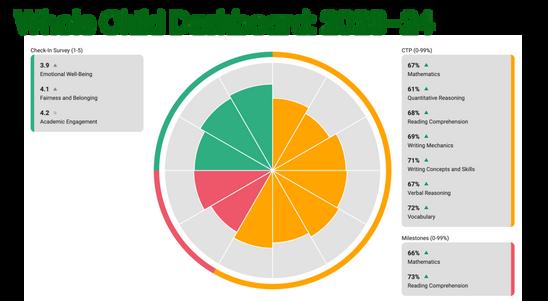
Our Episcopal identity is the foundation of our mission and values. This year, St. Patrick’s enhanced its Values curriculum by introducing monthly values, which highlight key characteristics that support our Community of Kindness and our 2024-25 school-wide theme, Growing Together in Kindness.
Each month, students focus on one of nine core values: kindness, responsibility, trust, gratitude, joy, respect, fairness, generosity, and courage. These values are integrated into the curriculum and classroom discussions, providing a shared language that all adults on campus can use to recognize and reinforce positive behavior.
To further embed these values into daily life, themed posters are displayed around campus, and Middle School students take the lead in designing and presenting monthly chapel talks that explore each value in depth. This initiative has strengthened our Values curriculum, reinforcing Social-Emotional Learning and Character Development throughout the year.
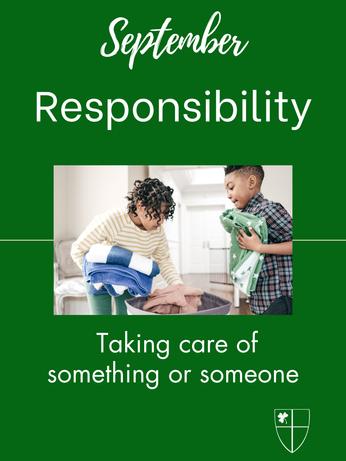


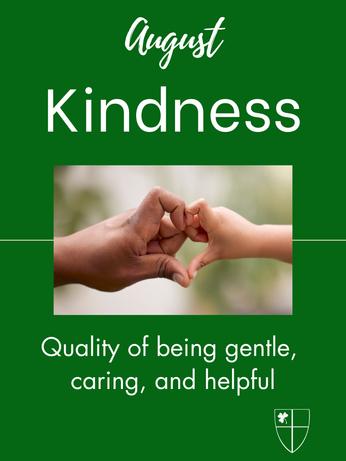

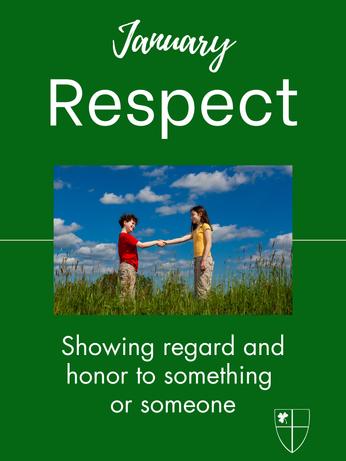

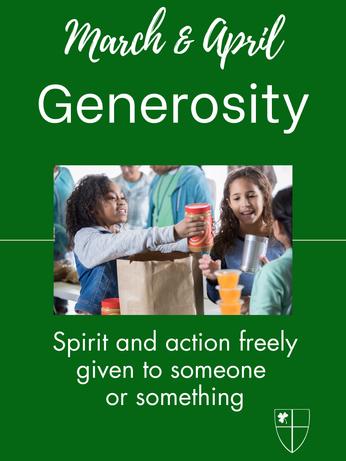
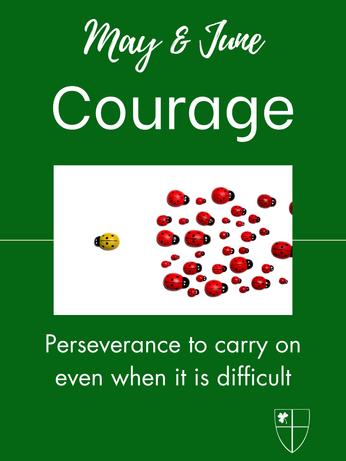
Our admissions process is accessible and welcoming. Families schedule a private or group tour through our website, social media, or printed ads. During their visit, prospective families view a slideshow showcasing the school, take a guided campus and classroom tour, and are interviewed to assess mission alignment.
Next, families receive a thank-you message with an invitation to apply. In addition to the application form, we require a teacher recommendation, two report cards, and standardized test scores when available. Applicants then complete a group assessment visit or a shadow day to evaluate cognitive, social, reading, writing, and math skills.
The admissions committee reviews each applicant’s results before making a unified decision. Families are then notified, and upon enrollment, we welcome them with a personal visit to deliver a St. Patrick’s yard sign and gift bag.
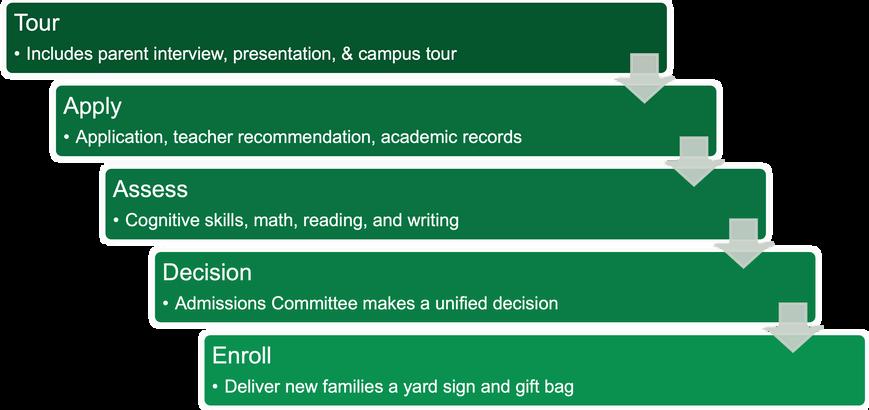
Beyond welcoming new families, the admissions role also involves working closely with our Social Media Director to create engaging social media and print materials. This year, we refreshed our lookbook and school brochure and enhanced our online presence with paid promotional boosts. Additionally, we introduced our very first poster advertisement at the Oaks Mall to expand our outreach.

It is important to consider how we think about our enrollment management strategy. Successful Enrollment Management considers much more than simply recruiting and enrolling new students; we also consider:
The school’s academic program and educational outcomes
Internal and external market data
Financial strategy
School’s composition and educational goals
In other words, our School’s Enrollment strategy requires a strong working relationship with many members of the St. Patrick’s leadership, faculty, staff, and parent community.


Looking at historic trends, before the pandemic, enrollment experienced a two-year decline. Today, it is as strong and stable as it has been in the past seven years While we expected some growth this year, enrollment remained steady due to an unusually small kindergarten class. With our full KR-8th grade program, we anticipate a target enrollment of approximately 175 students in the coming years.
While KR and kindergarten remain our primary entry points, we have also intentionally developed a new entry point at sixth grade, welcoming students transitioning from area public schools. St. Patrick’s provides the ideal environment for middle schoolers navigating these formative years, where they are truly seen and known, and where their leadership skills and values are intentionally developed, setting them up for success in high school and beyond
Since word of mouth remains our #1 source of new enrollments, we invite you to help us grow! If you know a family with elementary or middle school-aged children, please send them our way. By sharing your positive experiences, you help us welcome more mission-aligned families who enrich our school community. We truly appreciate your partnership in spreading the message about St. Patrick’s!
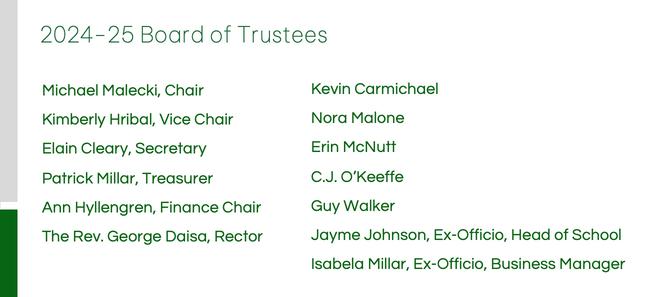
The Board of Trustees plays a strategic role in guiding the institution in three main areas:

First, the Board is responsible for financial oversight, ensuring that funds are used appropriately and that our reserves are invested wisely. This responsibility ranges from overseeing audits to leveraging our five-year financial model to make long-term decisions for example, in establishing the Middle School

Second, the Board defines and advances the Mission, Vision, and Strategy of the school For example, the Board authored the Mission statement: “To inspire and equip children to courageously transform the world.” In another instance, attracting and retaining the best staff is a strategic imperative, so the Board operationalizes this by ensuring competitive teacher compensation and allocating an appropriate budget for professional development.

Third, the Board exercises exclusive governance responsibilities, such as hiring the Head of School.
The Board and Head of School follow a well-established, widely used collaborative model for decisionmaking. Under this framework:
The Board retains accountability for strategic-level decisions.
The Board and Head collaborate on intermediate decisions.
The Head of School is accountable for operational decisions.
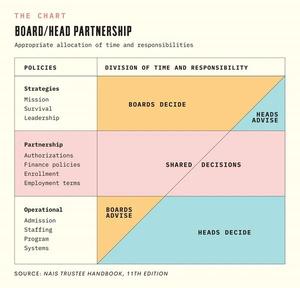
An example of this model in action is the addition of the Middle School: When multiple parents expressed interest in a Middle School, the Board’s first step was to evaluate whether or not the expansion aligned with our Mission After reflection and discussion, the Board recognized that expanding into Middle School would provide an opportunity for students to not only survive but thrive during these formative years.
To support this decision, the Chair of the Finance Committee developed a new financial model, enabling the Board and Head to evaluate the Middle School business case over multiple years. In partnership with the Board, the Head of School identified that the expansion would require additional subject-specific teaching resources. The Finance Chair then incorporated these additional staff and other costs into the financial model. While the initial years of the Middle School rollout presented a net cost, the model demonstrated how the program would achieve financial independence over a five-year horizon. Thus, developing a financial understanding of the expansion became a shared responsibility between the Board and Head.
While the Board set the expectation that our Middle School must uphold the high standards of St. Patrick’s, the translation of that vision into an academic program—such as math curriculum design, elective ideation, and course selection remained firmly within the Head of School’s domain.

93% of the funds for the school this year come from tuition.
6% come from donations (annual fund campaign, designated gifts, etc.).
0.4% was budgeted to come from Interest.
We are well-placed to surpass that through an improved Investment Strategy, as discussed on the next page.
75% of the school’s expenses go directly to compensation.
10% goes to tuition assistance (which comprises financial aid as well as tuition remission for faculty, sibling discounts, parishioner discounts, etc.)

Improved Investment Allocation: Increase return, simpler to operate, while being very safe.
Expectation is interest return becomes ~2% of income, rather than 0.5%. That's equal to 4 more students attending!
Due to improved, longer-range financial forecasting, the school was in position to make better use of the tuition dollars that are received at the start of the year but are spent more evenly across the year. This improved forecasting allowed us to invest in more aggressive accounts, thus generating higher returns, while still being certain of covering any upcoming expenses. This improved investment strategy is both simpler to maintain (all done in-house rather than through a financial advisor) and will likely generate around four-times the investment return. The net effect is the school’s interest income is the equivalent of adding four new students to the school.

Tuition covers 93% of this year ’ s planned income, with investment income helping but still leaving a gap. This is standard for private schools and not a concern The projected income-expense gap is approximately $250K for 2024–25 and $150K for 2025–26. Donations help bridge this gap, keeping tuition lower while maintaining standards and enhancing programs.

We are very excited that our Middle School program has begun. Now, we have to ensure the investment works out and the middle school portion can sustain itself.
Financial Timeline for the Middle School
Year 1: Investment and startup cost
Year 2 and 3: Break even as we ramp up to full scale
By Year 5: Fully self-sustaining; able to invest in improving programs
Based on initial enrollment numbers vs. budgeted expectations, the first 6 months are looking great. The middle school is slightly ahead of schedule.
St. Patrick’s is accredited by three well respected, regional organizations: the California Association of Independent Schools (CAIS), the Western Association of Schools and Colleges (WASC) and the Episcopal Diocese of Los Angeles. We are also members of the non-accrediting, national organizations, the National Association of Independent Schools (NAIS) the National Association of Episcopal Schools (NAES).


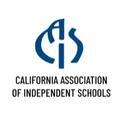


Schools are assessed in six key areas: Institutional purpose and core values
1. Teaching and learning
2. Financial sustainability
3. Operational purpose and core values
4. Institutional stewardship and leadership
6.
5. Institutional improvement and sustainability
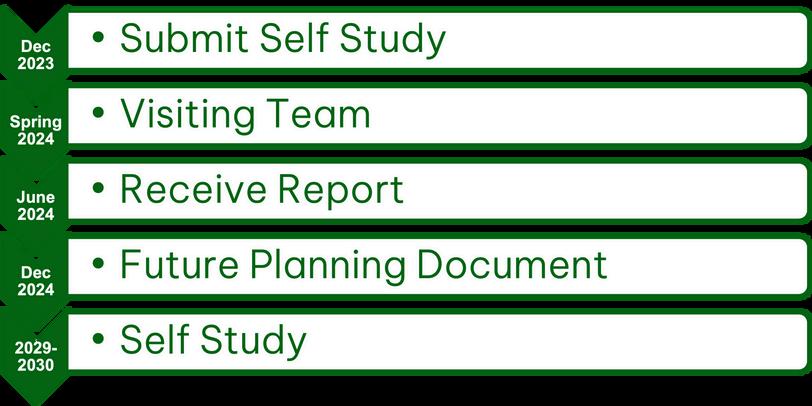
At last year ’ s State of the School, we shared that the St. Patrick’s was preparing to host a visiting team for our CAIS/WASC accreditation. We are proud to announce that St. Patrick’s successfully completed our California Association of Independent Schools (CAIS) accreditation and was awarded a full seven-year term. As part of this rigorous process, we received a comprehensive report with recommendations aligned to our strategic goals, guiding us in areas such as teaching and learning, financial sustainability, institutional stewardship, leadership, and overall school improvement. These recommendations are expected, and every accredited school receives recommendations. Over the next seven years, we will actively address these recommendations to ensure continued growth and excellence. This iterative process provides a cycle of accountability and growth for our school.
It is important to note that St Patrick’s is the only school in the Conejo Valley accredited by CAIS. While other local schools—including Oaks Christian, Bethany Christian, Ascension Lutheran, Hillcrest Christian, St. Pascal’s, and Carden Conejo hold WASC and other accreditations, they do not meet the higher standards set by CAIS. CAIS accreditation requires inclusive, nondiscriminatory policies and a demonstrated, ongoing commitment to educational excellence and continuous school improvement.
Recommendations 1-3 are operational, falling primarily under the purview of the Head of School.
1. Teaching and Learning: Educational Program
Curriculum review
Scope and sequence documentation
Ensure curriculum is current, research based, and aligned across grades
School-wide, consistent SEL and behavior resources
2. Teaching and Learning: Faculty and Pedagogy
Articulate school-wide pedagogical philosophy
Differentiate curriculum to support all learners
Formalize and monitor collection of data on student progress
3. Teaching and Learning: Employe Professional Development and Growth
Create a formal faculty and staff growth and evaluation process
Prioritize professional development
Support individual professional goals and school wide initiatives
Recommendations 4-6 are more strategic, and will be overseen by the Board of Trustees.
4. Financial Sustainability: Finance
Document policies to guide fundraising, financial planning, and strategies that support the financial health and long-term sustainability
5. Intuitional Stewardship and Leadership: Governance
Goal setting and self evaluation protocol for trustees
Support Head of School in goal setting and reflection
6. Institutional Improvement and Sustainability
Engage in a strategic planning process
St. Patrick’s has made meaningful advancements in implementing key initiatives outlined in Recommendations 1-3. By emphasizing curriculum development, professional growth opportunities, and strategic planning, we continue to enhance our academic programs and provide valuable support to our faculty and staff. The following updates showcase our progress in these areas, underscoring our dedication to continuous improvement and educational excellence.
Recommendation 1: Significant progress has been made in curriculum development and professional growth initiatives. A two-year curriculum documentation project has established clear monthly learning goals across subjects and grade levels. Recent curriculum adoptions in science (K-7), social studies (K-7), health (4-7), and handwriting (KR, K, 2, 4) have contributed to a comprehensive curriculum map, with Semester 1 updates completed and Semester 2 expected by June The finalized scope and sequence will be distributed at our next Back-to-School Night. Additionally, an evaluation of grade-level novels for grades 3-8 is in progress. To support professional development, faculty have participated in multi-session workshops on newly adopted curriculum areas, and six teachers will attend off-campus conferences this year.
Recommendation 2: In January, core teachers began defining St. Patrick’s pedagogical philosophy, laying the foundation for a unified approach to teaching and learning. This work will continue in March, expanding to include teaching assistants and specialists. The goal is to develop a published pedagogical philosophy that will guide faculty recruitment and shared on the school website to serve as a valuable resource for prospective families.
Recommendation 3: To support professional growth and development, all employees participated in one-on-one goal-setting meetings with Dr Johnson this fall. These meetings allowed individuals to articulate goals, define measurable outcomes, and request support as needed. Looking ahead, a committee will develop a more formalized growth and evaluation process this summer, with plans to roll-out phase one of the system in Fall 2025.


